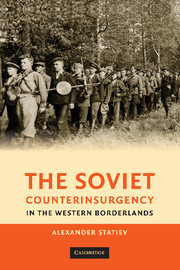Book contents
- Frontmatter
- Contents
- List of Figures
- List of Tables
- Acknowledgments
- Glossary
- Introduction
- 1 Origins of Soviet Counterinsurgency
- 2 The Borderland Societies in the Interwar Period: The First Soviet Occupation and the Emergence of Nationalist Resistance
- 3 The Borderlands under German Occupation (1941–1944): Social Context of the Soviet Reconquest
- 4 Nationalist Resistance after the Soviet Reconquest
- 5 Soviet Agrarian Policy as a Pacification Tool
- 6 Deportations, “Repatriations,” and Other Types of Forced Migration as Aspects of Security Policy
- 7 Amnesties
- 8 Red Rurales: The Destruction Battalions
- 9 Police Tactics: Actions of NKVD Security Units, Intelligence Gathering, Covert Operations, and Intimidation
- 10 The Church in Soviet Security Policy
- 11 Violations of Official Policy and Their Impact on Pacification
- 12 Conclusion: Nationalist Resistance and Soviet Counterinsurgency in the Global Context
- Appendix A Note on Used Terms and Geographic and Personal Names
- Appendix B Note on Primary Sources
- Bibliography
- Index
5 - Soviet Agrarian Policy as a Pacification Tool
Published online by Cambridge University Press: 05 May 2010
- Frontmatter
- Contents
- List of Figures
- List of Tables
- Acknowledgments
- Glossary
- Introduction
- 1 Origins of Soviet Counterinsurgency
- 2 The Borderland Societies in the Interwar Period: The First Soviet Occupation and the Emergence of Nationalist Resistance
- 3 The Borderlands under German Occupation (1941–1944): Social Context of the Soviet Reconquest
- 4 Nationalist Resistance after the Soviet Reconquest
- 5 Soviet Agrarian Policy as a Pacification Tool
- 6 Deportations, “Repatriations,” and Other Types of Forced Migration as Aspects of Security Policy
- 7 Amnesties
- 8 Red Rurales: The Destruction Battalions
- 9 Police Tactics: Actions of NKVD Security Units, Intelligence Gathering, Covert Operations, and Intimidation
- 10 The Church in Soviet Security Policy
- 11 Violations of Official Policy and Their Impact on Pacification
- 12 Conclusion: Nationalist Resistance and Soviet Counterinsurgency in the Global Context
- Appendix A Note on Used Terms and Geographic and Personal Names
- Appendix B Note on Primary Sources
- Bibliography
- Index
Summary
The agrarian reform was a spearhead of the Rebel Army.
–Ernesto GuevaraThe Soviet counterinsurgency doctrine has never been articulated as a counterinsurgency manual, yet Politburo members knew how the Bolsheviks had won the civil war. Facing a nationalist challenge in the borderlands, the Soviet regime responded with a set of political, military, and security measures it had developed during the civil war. Its stick-and-carrot strategy presumed a combination of populist reforms intended to win the hearts of the poorer majority, harsh punitive policies designed to eliminate all actual and potential opponents, and amnesties that would allow all proletarians and their class allies who accidentally found themselves among the Soviet enemies to switch sides. The Soviet leaders viewed insurgency as an inevitable class conflict; therefore, it was vital to involve the borderland poor in the struggle against the resistance, organize them politically and militarily by appointing them to local administrative positions and by raising peasant militia, and lead them against the enemies of the proletarian state. This class struggle was to culminate in a social revolution controlled and directed by the state. Agrarian reform was the major political means with which to instigate a class conflict that would end with the destruction of the resistance by the joint force of the state security agencies, the proletariat, and its allies – peasants. The theory of class conflict, however, was always ambivalent with regard to the peasantry.
- Type
- Chapter
- Information
- The Soviet Counterinsurgency in the Western Borderlands , pp. 139 - 163Publisher: Cambridge University PressPrint publication year: 2010



